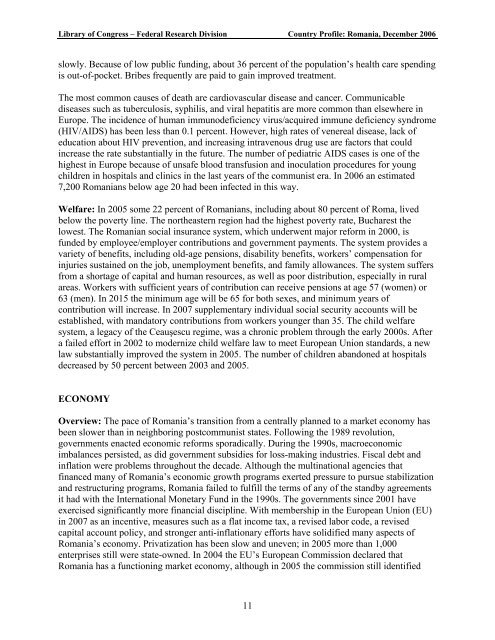Country Profile: Romania - Library of Congress
Country Profile: Romania - Library of Congress
Country Profile: Romania - Library of Congress
You also want an ePaper? Increase the reach of your titles
YUMPU automatically turns print PDFs into web optimized ePapers that Google loves.
<strong>Library</strong> <strong>of</strong> <strong>Congress</strong> – Federal Research Division <strong>Country</strong> <strong>Pr<strong>of</strong>ile</strong>: <strong>Romania</strong>, December 2006<br />
slowly. Because <strong>of</strong> low public funding, about 36 percent <strong>of</strong> the population’s health care spending<br />
is out-<strong>of</strong>-pocket. Bribes frequently are paid to gain improved treatment.<br />
The most common causes <strong>of</strong> death are cardiovascular disease and cancer. Communicable<br />
diseases such as tuberculosis, syphilis, and viral hepatitis are more common than elsewhere in<br />
Europe. The incidence <strong>of</strong> human immunodeficiency virus/acquired immune deficiency syndrome<br />
(HIV/AIDS) has been less than 0.1 percent. However, high rates <strong>of</strong> venereal disease, lack <strong>of</strong><br />
education about HIV prevention, and increasing intravenous drug use are factors that could<br />
increase the rate substantially in the future. The number <strong>of</strong> pediatric AIDS cases is one <strong>of</strong> the<br />
highest in Europe because <strong>of</strong> unsafe blood transfusion and inoculation procedures for young<br />
children in hospitals and clinics in the last years <strong>of</strong> the communist era. In 2006 an estimated<br />
7,200 <strong>Romania</strong>ns below age 20 had been infected in this way.<br />
Welfare: In 2005 some 22 percent <strong>of</strong> <strong>Romania</strong>ns, including about 80 percent <strong>of</strong> Roma, lived<br />
below the poverty line. The northeastern region had the highest poverty rate, Bucharest the<br />
lowest. The <strong>Romania</strong>n social insurance system, which underwent major reform in 2000, is<br />
funded by employee/employer contributions and government payments. The system provides a<br />
variety <strong>of</strong> benefits, including old-age pensions, disability benefits, workers’ compensation for<br />
injuries sustained on the job, unemployment benefits, and family allowances. The system suffers<br />
from a shortage <strong>of</strong> capital and human resources, as well as poor distribution, especially in rural<br />
areas. Workers with sufficient years <strong>of</strong> contribution can receive pensions at age 57 (women) or<br />
63 (men). In 2015 the minimum age will be 65 for both sexes, and minimum years <strong>of</strong><br />
contribution will increase. In 2007 supplementary individual social security accounts will be<br />
established, with mandatory contributions from workers younger than 35. The child welfare<br />
system, a legacy <strong>of</strong> the Ceauşescu regime, was a chronic problem through the early 2000s. After<br />
a failed effort in 2002 to modernize child welfare law to meet European Union standards, a new<br />
law substantially improved the system in 2005. The number <strong>of</strong> children abandoned at hospitals<br />
decreased by 50 percent between 2003 and 2005.<br />
ECONOMY<br />
Overview: The pace <strong>of</strong> <strong>Romania</strong>’s transition from a centrally planned to a market economy has<br />
been slower than in neighboring postcommunist states. Following the 1989 revolution,<br />
governments enacted economic reforms sporadically. During the 1990s, macroeconomic<br />
imbalances persisted, as did government subsidies for loss-making industries. Fiscal debt and<br />
inflation were problems throughout the decade. Although the multinational agencies that<br />
financed many <strong>of</strong> <strong>Romania</strong>’s economic growth programs exerted pressure to pursue stabilization<br />
and restructuring programs, <strong>Romania</strong> failed to fulfill the terms <strong>of</strong> any <strong>of</strong> the standby agreements<br />
it had with the International Monetary Fund in the 1990s. The governments since 2001 have<br />
exercised significantly more financial discipline. With membership in the European Union (EU)<br />
in 2007 as an incentive, measures such as a flat income tax, a revised labor code, a revised<br />
capital account policy, and stronger anti-inflationary efforts have solidified many aspects <strong>of</strong><br />
<strong>Romania</strong>’s economy. Privatization has been slow and uneven; in 2005 more than 1,000<br />
enterprises still were state-owned. In 2004 the EU’s European Commission declared that<br />
<strong>Romania</strong> has a functioning market economy, although in 2005 the commission still identified<br />
11

















